Do you think this medal is genuine or a copy?? riddle solved by coinJP.
 keets
Posts: 25,351 ✭✭✭✭✭
keets
Posts: 25,351 ✭✭✭✭✭
The medal in question is being offered for sale as Eglit 107/59mm. and issued by Stefano Johnson of Milan, Italy for the 1892-3 World's Columbian Exposition. It seems that it is probably a modern copy which is what the appearance looks like to me. The overall detail is soft and seems matte, almost sand-blasted. For comparison, the top medal is one that I own.
Sharper detail and semi-reflective fields. Note the reverse die crack which is on every Eglit 107 I have ever seen in every alloy type.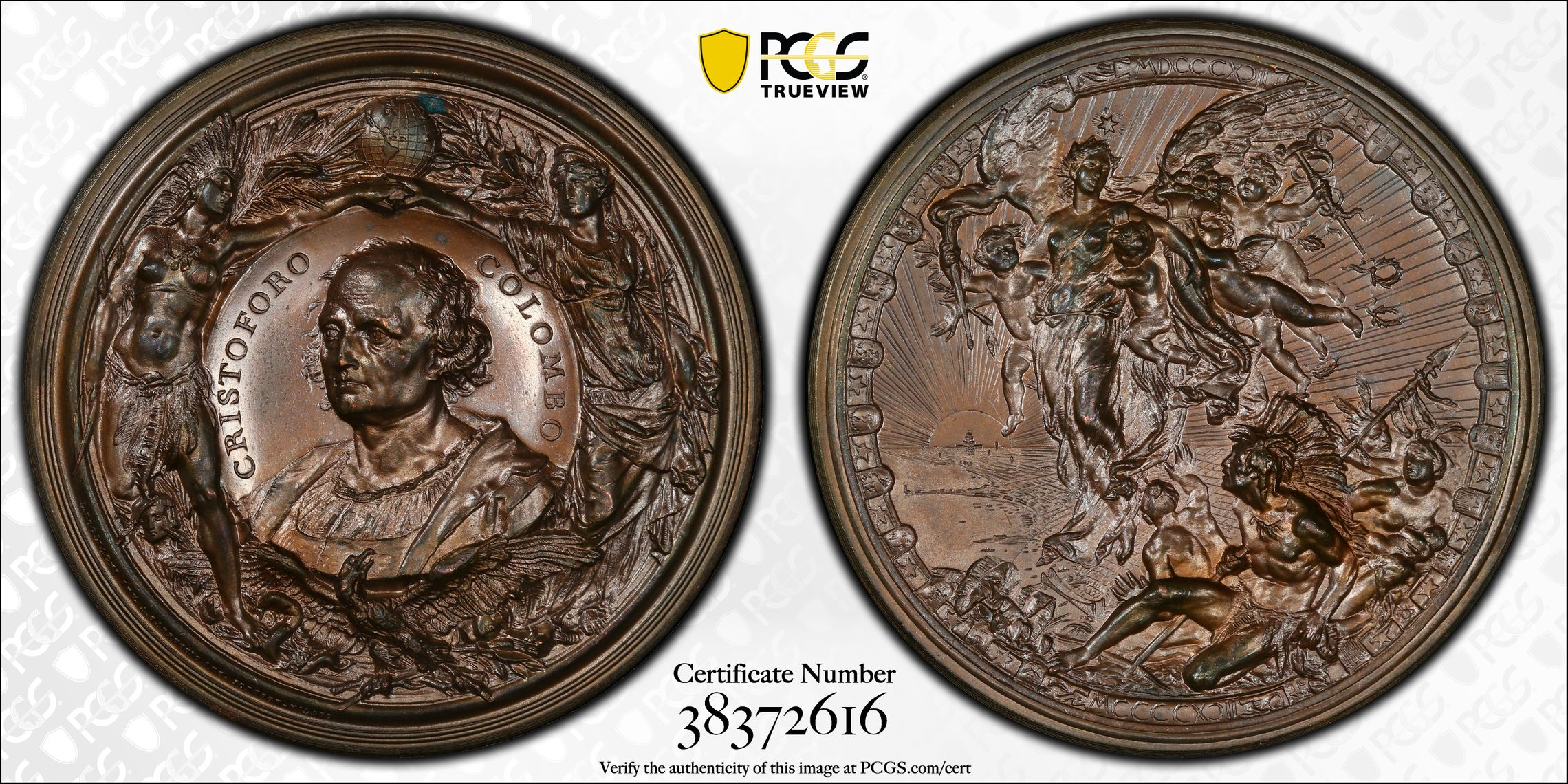
This is the medal being offered as a genuine Eglit 107. Note the soft detail, matte-like in appearance and the absence of the reverse die crack. The color is also much lighter, the yellow bronze used in the 20th century for a lot of medals.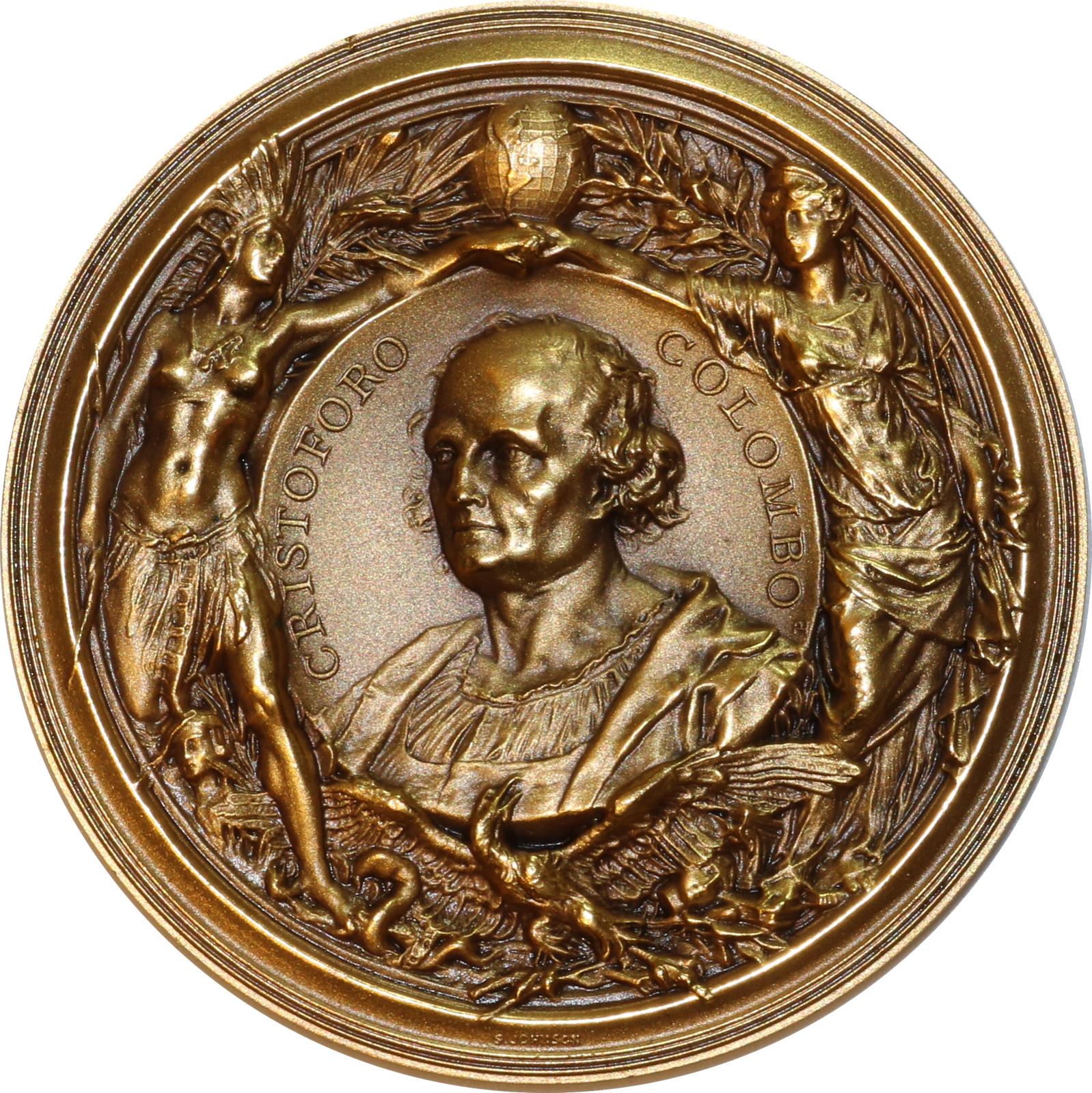
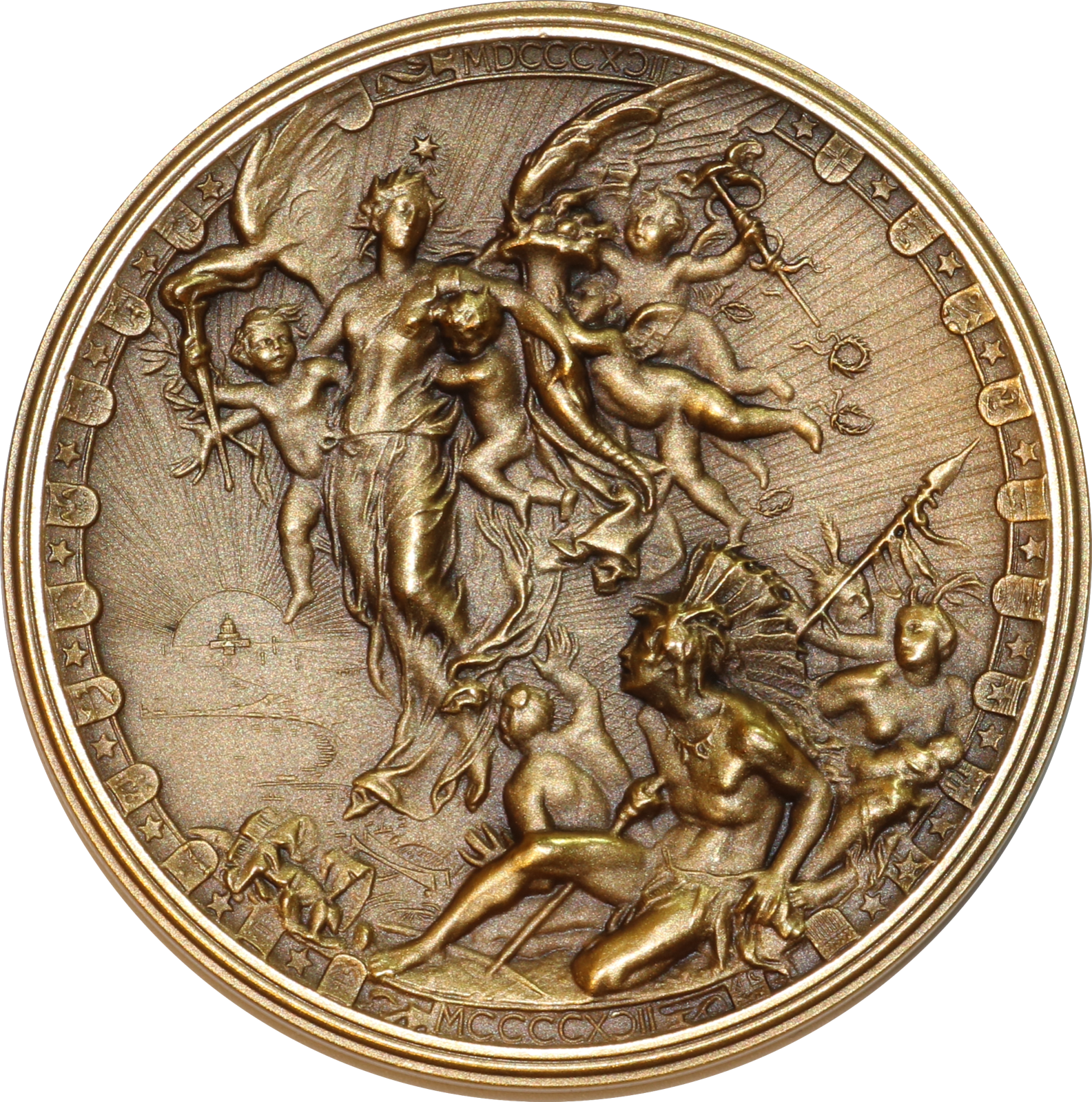
This is a medal issued in 1922 for a World Conference held in Genoa, Italy and presented to Delegates. It has a similar color and a similar finish as the suspect medal.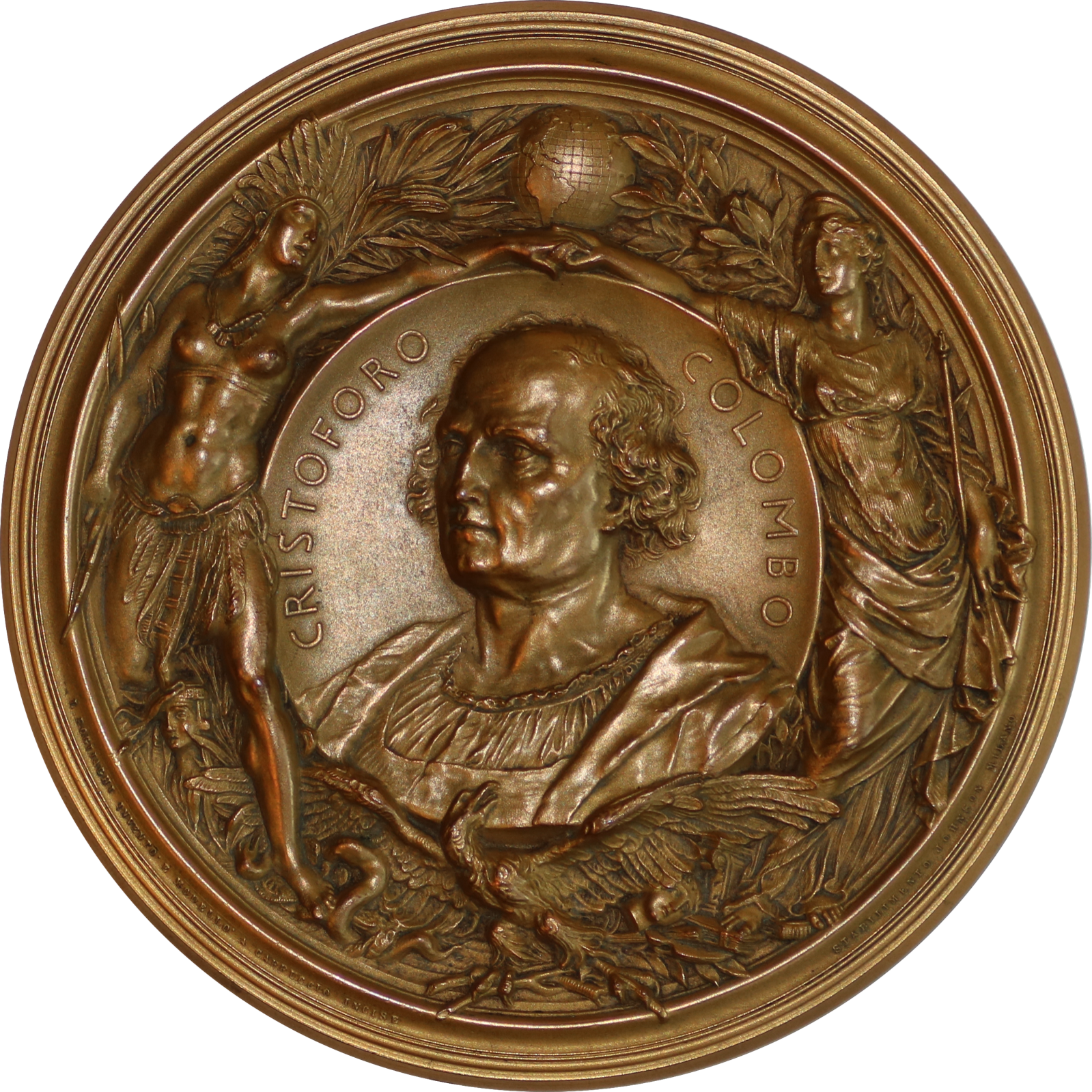
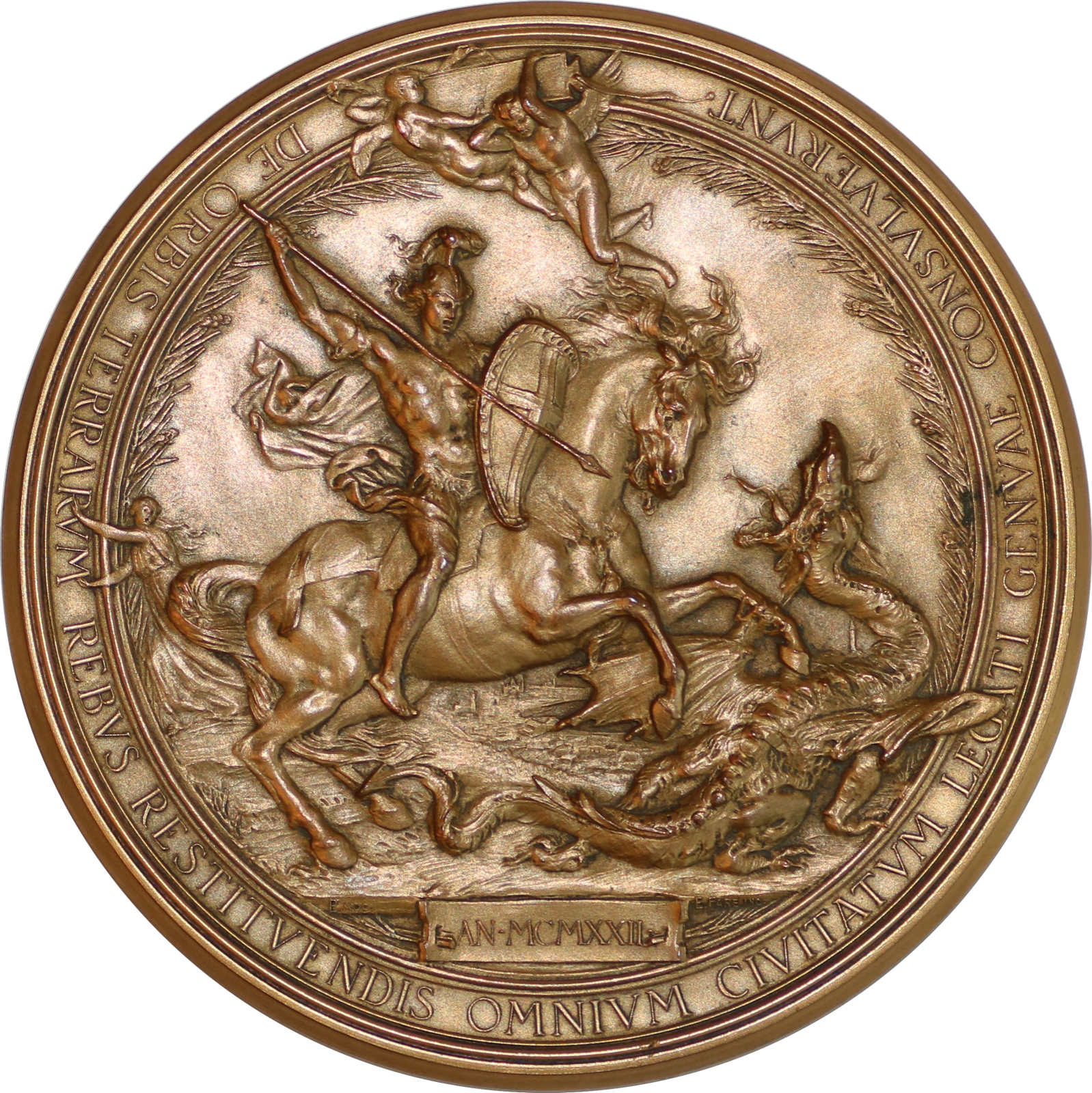
I would ask what everyone thinks. Is the medal in the middle probably a counterfiet/re-issue being sold as genuine or do you think it's legitimate?? The biggest "tell" for me is the die crack. I have always assumed that there might/must be medals without the crack, but since those would be earlier strikes it would follow that they'd have sharper detail and smoother surfaces overall.
Thanks for your input.
Al H.
Comments
would the genuine die have a die crack from the very beginning?
the circled area is the location of the die crack which continues across the medal.
would the genuine die have a die crack from the very beginning
I have no way of knowing but suspect it did when it was used for these medals, Eglit 107. the same reverse was used for Eglit 105, which had a different obverse, but those also show the die crack. again, I don't know which of the two was struck first only how they are catalogued.
Fascinating.
Die alignment normal?
Edge? Thickness? Weight?
Die alignment normal? Edge? Thickness? Weight?
nothing is given except the diameter.
also, I have a 40mm example of this medal dated in Roman Numerals(MCMXCII) as 1992, from a seller in Italy.
It is probably a restrike, perhaps from newly prepared dies, to suit collector demand from 100 years ago (1920's). This would not be unusual in the field of medals.
I agree, but it's represented as an original and priced the same, hence, my inquiry.
What is the technical difference between any of these and how would you differentiate between them?:
a) Different finish by original minter
b) Restrike by original minter
c) Replica by original minter
d) Restrike by different minter
e) Replica by different minter
f) Counterfeit
Unless the original cataloguer specifically excludes options A, B, C, D, and E from the attribution, then those should all be considered Eglit-107.
Looks like a later copy to me. Not sure if it's the angle of the picture but underneath the eagle there seems to be more words on the original compared to the suspect medal?
What is the technical difference between any of these and how would you differentiate between them? Unless the original cataloguer specifically excludes options A, B, C, D, and E from the attribution, then they should all be considered Eglit-107.
although I don't recall reading directly that Nathan Eglit states as much, it's pretty clear that his catalogue is of items issued for and sold in connection with the WCE of 1892-93. other collectors can opine on that point but it seems pretty clear. that renders your "a-e" as moot. my main question to the board is to decipher if this is an original medal struck for and issued at the exposition(s) or one of your post exhibition examples.
the seller states it was made in 1892?? do you think it was??
How doers the seller know that it was struck in 1892? Is he just making an assumption based on the date on the medal?
Interesting that your "original" medal has some text on the obv, bottom, left and likewise the 1922 issue. But the medal in question has something different and more centered. Can you make that out with a loop?
That matte surface finish was not common in the early 1890s, in the US or elsewhere. My guess is that it is likely not a contemporary strike.
However, if the same dies were used, it would still be difficult to prove, without a doubt, that it wasn’t contemporary. If it was a later strike, a tiny hairline crack like that could be erased by any special surface finishing that was done.
It’s hard to do a side-by-side comparison on my phone to tell if they are the same dies.
there seems to be more words on the original compared to the suspect medal?
wow, coinJP nails it!!!
I was so fixated on the reverse and the die crack that I never really looked at the obverse very close.
--- on the originals it says L. Pagliaghi I N V - A. Capuccio I S Q - Johnson -Milano _.
--- the copy says _S. Johnson.
I'm sort of embarrassed that I din't notice that, but like I said, it was all about that reverse.
not Moonlight Mint?
So that disproves that it’s an Eglit-107, but does not definitively conclude whether it is a contemporary striking.
But who is the mysterious S. Johnson and when was he active?
the medal Designer was Pagliaghi, the Die Engraver was Capuccio and the medals were struck and issued by Johnson in Milan, Italy.
Glad I could help Keets!!
Interesting medal.
Wow that is a beautiful peace of medal art. The amount of detail is amazing! Ty for sharing.
Stefano Johnson founded his firm in 1836 -- the company (at last report) is still in business. S. Johnson's son Federico was in charge during the Columbian Expo and is credited with expanding the scope and quality of the firm by hiring engravers from the Italian branch mint in Milan which closed in 1887. I've been unable so far to find a date of death for Stefano Johnson but then again I haven't tried that hard -- I eat but do not read or speak Italian..
Mystery solved... Cool... And that is one, beautiful medal... If I collected medals, that would be one I would certainly have. Cheers, RickO
notice the rim script on the medal from 1922, it reads L Pagliaghi - Invento E Modello - A Capuccio - Incise. using an Italian-English translator that reads L Pagliaghi - I Invent and Model - A Capuccio - Engraved . along the opposite rim is Stabilimento Johnson Milano, which translates to Establishment Johnson Milano. I know that Stefano Johnson's Company was destroyed in bombing raids sometime around 1943 during WWII and rebuilt. I'm not sure how long they operated and if they are still in business.
it seems that S. Johnson Medalists struck the latter medal in 1922 and I suppose they also struck the latter in the 1990's. I sent an e-mail to the seller and explained to him that the medal he's offering for sale isn't one that was issued for the 1892-3 Exhibition, pointing out the differences. I'm still waiting for a reply.
Stefano Johnson's grandson was Stefano Johnson II. Could the second one signed "S. Johnson" be signed by the grandson?
https://collection.sciencemuseumgroup.org.uk/people/cp80869/stabilimento-spa-stefano-johnson
well, after all this time the above seller has again listed this Modern Reproduction on eBay as an 1892 original. apparently enough people have been duped since the bidding is over $200 with eight days remaining.
sad that someone will be scalped.
this seller is taking another unsuspecting group of bidders for a haircut, over $400 now for a $30 modern reproduction that they offer as "made in 1892" by Johnson. they probably have an unlimited supply of these and will continue to sell them as long as buyers keep bidding.
https://ebay.com/itm/400th-Anniversary-Discovery-of-America-1892-Christopher-Columbus-Medal-59mm/373518480787?hash=item56f76fb593:g:QTMAAOSwWxtgYd3p
There was a guy named “Johnson” (I have forgotten his first name.) who made copies of Brenner’s Lincoln plaque in the 1970s. Ignorant or dishonest dealers sold these copies as original pieces, usually cheating the buyers out of hundreds of dollars.
I don’t like the piece in question. It lacks the sharpness of the original, and can’t have the same value.
Reported
PCGS has actually encapsulated one of these, cert. #40121183 and dated 1992 in their database.
Do you think there's anything wrong with encapsulating this?
It seems a bit like PCGS slabbing all the new Libertas Americana medals from the Paris Mint.
Here are some more photos:
@keets said:
This example is dated 1992 on the reverse of the medal. It is dated MCMXCII whereas the original is dated MCCCCXCII.
This example is dated 1992 on the reverse of the medal
--- didn't I already say that??
Do you think there's anything wrong with encapsulating this?
Zoins, I don't have any problem with PCGS or anyone else encapsulating these. they call it what it is. the problem is that the seller is selling it as an original 1892 issue which it clearly is not.
Yes, but the medal that PCGS encapsulated is different than the medal that the eBay seller is selling. The PCGS encapsulated medal is irrelevant.
there are several versions with different dates.
BTW, these are coming out of Italy.
I do not know whether it is genuine or not, but here is one off CoinFacts that I do not see the die crack on the reverse. Perhaps just my eyes or the lighting. All the rest show have the die crack very prevalent.
Jim
When a man who is honestly mistaken hears the truth, he will either quit being mistaken or cease to be honest....Abraham Lincoln
Patriotism is supporting your country all the time, and your government when it deserves it.....Mark Twain
Should someone publish a paper or booklet on these? Seems like it could be worthwhile.
the die crack is very fine and runs across the entire reverse emerging on the opposite field at around the two-o'clock position. these images are not focused very well and enlarging them doesn't help much. it looks like the crack is apparent in the area I indicated, but it is hard to see because of its fineness and the blurry photo.
I frequently see sellers state in the item descriptions: " I am not an expert on the item, I have no knowledge about this item, please look at the pictures carefully...".
If they do not say it is "original", but only say the above, is it ok?